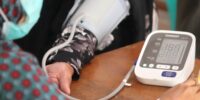Seven important items of medical research from China

N95 masks don’t work for Chinese faces
The specialised N95 face masks used to protect against infections such as influenza are not shaped to fit Chinese faces and most would fail to prevent transmission because of poor fit and leakage, tests by Wuhan researchers have shown. Evaluation tests on ten different types of N95 mask found that only two performed within acceptable limits to prevent transmission of infections. Performance of some masks was better when users were trained and they were specially fitted, the study in PLOS One showed.
“This study indicated that widely used N95 filtering facepiece respirators in China didn’t fit well and can’t provide desired protection for respirator users,” the researchers concluded.
Malaria from Africa now a problem in China
Malaria has been virtually eliminated in China but doctors now face the problem of treating malaria in Chinese workers who have returned from Africa. In Jiangsu there have been 918 malaria cases and six deaths in the last decade due to malaria imported from other countries. The imported cases make up 12% of all malaria cases and account for all malaria deaths, according to researchers from the Jiangsu Institute of Parasitic Diseases, Wuxi, writing in the Malaria Journal.
No cardiovascular treatment for many Chinese patients
Two out of three Chinese people with cardiovascular disease are still going untreated, a major study has found. Data from of 512,891 Chinese adults showed that 5% had a history of cardiovascular disease. However, of these only 35% had been treated with any cardiovascular medicine for secondary prevention such as statins, antiplatelet drugs or antihypertensives. The findings from a team from Oxford and Beijing universities, are published in the International Journal of Cardiology.
Shenzhen women have high rates of HPV
More than one in ten women in Shenzhen are have HPV serotypes that put them at risk of cervical cancer, researchers say. A study of 4, 413 women measured HPV infection rates and the prevalance was 14%. The high risk HPV types 16 and 18 that are likely to cause cervical cancer were found in 3.5% of women and 1.27% of women, according to the study published in the Asia Pacific Journal of Cancer Prevention.
Avian H7N9 flu virus on way to mutation
The H7N9 influenza virus is genetically much more diverse than previously thought, suggesting that it is reassorting and closer to mutating into a pandemic virus, researchers from the Jiangsu Provincial Center for Disease Control and Prevention, have shown. They report their findings in Nature.
Medical teacher burnout
Staff at medical colleges in China have high rates of burnout, a study from Shanxi shows. Staff who had a love of teaching and those who received praise and recognition were less likey to suffere burnout, according to the study in Archives of Environmental & Occupational Health.
Pancreatic cancer in Shanghai
The diagnosis and treatment of pancreatic cancer in Shanghai has room for improvement, according to researchers from Fudan University. In a review of management of pancreatic cancer published in Cancer Letters, they report that most patients miss out on the recommended histologically verified diagnosis and the 1-year and 2-year survival rates were 35% and 14.4%, respectively.








